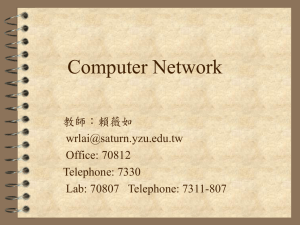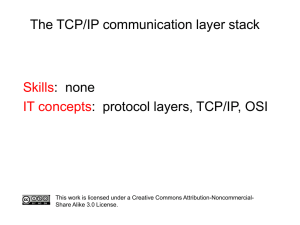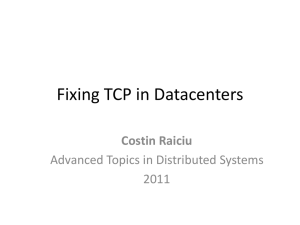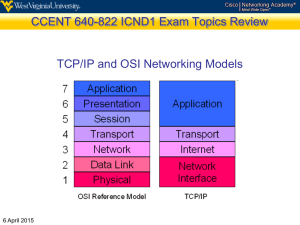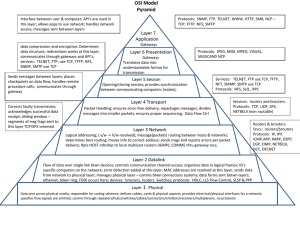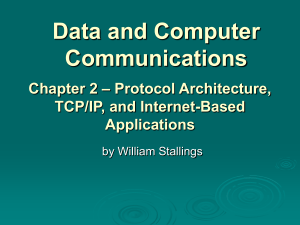投影片下載
advertisement
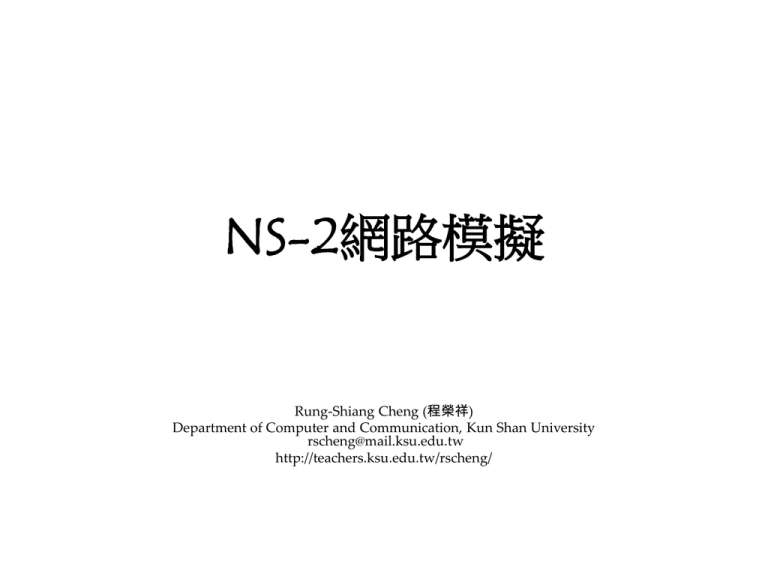
NS-2網路模擬
Rung-Shiang Cheng (程榮祥)
Department of Computer and Communication, Kun Shan University
rscheng@mail.ksu.edu.tw
http://teachers.ksu.edu.tw/rscheng/
Outline
NS-2基本操作
– NS-2安裝與設定(for Linux)
– 個別套件的安裝
範例介紹
– Improving TCP Performance with Bandwidth Estimation
and Selective Negative ACK Wireless Networks
NS-2安裝與設定(for Linux)
3
NS-2是什麼?
Network Simulator, version 2
– 物件導向網路模擬器
– C++, OTCL
– Router, Link, End point, TCP/IP protocols
– Ethernet, WiFi, Sensor Networks
4
NS-2的下載與安裝
下載NS-2
– NS-2網址 http://www.isi.edu/nsnam/ns/
– Download and Build ns
• Getting everything at once
• Ns-allinone 套件
選擇 current release 2.XX
5
NS-2的下載與安裝
安裝NS-2
– 解壓縮
– 安裝
– 開始進行安裝….
NS-2的下載與安裝
各別套件的安裝位置
7
NS-2的下載與安裝
安裝完成訊息
8
NS-2的下載與安裝
修改使用者環境設定
將NS-2要求設定的路徑,加入PATH參數中
9
.bashrc範例
10
測試可否使用Network Animator
請在命令列(Command Line)輸入nam指令
若可以看到下列視窗表示nam安裝成功 (若否,則進行個別
套件安裝)
目前使用的
是1.13版
個別套件的安裝 – 以NAM為例
Download and Build ns
– Getting the Pieces
最新版本的
nam
12
下載新版的nam
將下載的檔案移至NS-allinone的目錄下
原先的版本是nam-1.13,新的版本是nam-1.14
個別套件的安裝 – 以NAM為例
使用tar指令將下載的檔案解壓縮
開始進行安裝
…..(省略)……
14
個別套件的安裝 – 以NAM為例
檢查是否產生nam執行檔
指定使用新的NAM版本來取代舊的NAM版本
15
測試可否使用新安裝好的Network Animator
請在命令列(Command Line)輸入nam指令
若可以看到下列視窗表示nam安裝成功
目前使用的
版本已經更
新為1.14版
Getting Older Versions of Ns
17
開始使用NS-2
Hello World程式
如何使用NS-2進行網路模擬
NS-2的執行流程
19
如何使用NS-2進行網路模擬
設計模擬劇本
產生網路拓撲
產生網路流量
利用NAM觀察模擬過程
The first TCL script (1/3)
使用文字編輯器輸入下列TCL程式碼 (檔名為template.tcl)
程式碼來源 ⇒ http://www.isi.edu/nsnam/ns/tutorial/index.html
The first TCL script (1/3)
在命令列輸入ns template.tcl
The first TCL script (1/3)
執行結果
沒有任何東西….(因為尚未產生網路拓撲)
產生網路拓撲 (2/3)
加入這段
程式碼:
產生2個node並
建立duplex-link
程式碼來源 ⇒ http://www.isi.edu/nsnam/ns/tutorial/index.html
The first TCL script (2/3)
重新執行程式
已經產生網路拓樸,但沒有資料在
傳送….
The first TCL script (3/3)
再接下去
加入這段
程式碼:
產生CBR流量並
設定傳資料的起
始和結束時間
The first TCL script (3/3)
修改後, 重新執行程式
經過0.5秒後開
始傳送資料
按下play…
Improving TCP Performance with Bandwidth
Estimation and Selective Negative ACK
Wireless Networks
Rung-Shiang Cheng
Assistant Professor
Department of Computer and Communication, Kun Shan University
Email: rscheng@mail.ksu.edu.tw
1. Rung-Shiang Cheng, Hui-Tang Lin, Improving TCP Performance with Bandwidth Estimation and Selective Negative
Acknowledgment in Wireless Networks, Journal of Communications and Networks, vol. 9, no. 3, pp. 236-246, Sep. 2007.
(SCI)
Outline
Introduction
TCP Congestion Control
TCP Enhancement
– Bandwidth Estimation Schemes for TCP over High-Speed
Networks
– SNACK-based Error Recovery Scheme
Conclusion
TCP Overview
TCP is the most widely used Internet protocol
– Web, FTP, Telnet, E-mail, Peer-to-peer etc.
A two way, reliable, connection-oriented protocol
– Reliable data transfer
• Byte-stream
– App writes bytes, TCP sends segments
– Flow control: keep sender from overrunning receiver
– Congestion control: keep sender from overrunning
network
30
Reliability in TCP
Checksum used to detect bit level errors
Sequence numbers used to detect sequencing errors
– Duplicates are ignored
– Reordered packets are reordered (or dropped)
– Lost packets are retransmitted
Timeouts used to detect lost packets
– Requires RTO calculation
– Requires sender to maintain data until it is ACKed
31
Motivation
Why Study TCP Performance
– Dependence on TCP/IP networks
• More people rely on TCP/IP networks than ever before
– Emergence of New Networking Technologies
• TCP algorithms suitable for one environment, do not always work best in
another, e.g., Wireless (WiFi, WiMax), satellite, High-speed
networks etc.
• Need for research into new algorithms
Critical Role of TCP
– Many believe that network performance can be boosted by simply
upgrading hardware
– TCP has total control of how application data should be released to the
network
– Unless TCP is optimized, hardware alone cannot boost network
performance
32
Congestion Control
Approach: increase transmission rate (congestion window
size), probing for usable bandwidth, until loss occurs
– additive increase: increase cwnd by 1 MSS every RTT
until loss detected
– multiplicative decrease: cut cwnd in half after loss
W 1,
W 1 / W ,
W
W / 2,
1,
S low- startph ase, if W Wt
C on ge stion
avoidan ce, if W Wt
if congestion(receivetriple- duplicateACK)
upon timerexpiry
W: congestion window
Wt: slow-start threshold
33
Poor Link Unitization at High BandwidthDelay Product (BDP) Networks
Internet’s subsequent growth and worldwide expansion has
meant faster links and increased diversity in network access
technologies
TCP congestion control performs poorly as bandwidth or delay
increases
– TCP increases by 1 Packet/RTT even if spare bandwidth is
huge
– A single TCP flow can saturate a 10Gbps link where there
is unrealistically low packet loss
Because TCP lacks fast response
34
Enhanced Startup Procedure
Two changes in the modified start-up procedure
– An appropriate initial threshold
– Smooth the transition from the slow-start phase to the
congestion-avoidance phase
Goal
– Fast response to currently available bandwidth
– Friendly to TCP flows that potentially share bandwidth
– Scalable (no per-flow state)
35
Enhanced Startup Procedure
W
(1)
t
W t b q (2)
W (b q )
1
bq
(3)
t
t
1
1
(4)
b q 1
t
Based on Eq. (4), Wt is computed every round-trip
Wt t
(5)
36
Enhanced Startup Procedure
The source updates its window size for each ACK received, as
follows:
W
W 1 ,
W
Wt
W 1 / W ,
S l owstart, if W Wt
C on ge stion
avoidan ce, if W Wt
When a triple-duplicate ACK is received:
ˆ m/ tlong (7)
Wt W / 2
W max { Wt , ˆ t }
(8)
37
(6)
加入自行修改的TCP模組
切換目徑至tcp 目錄下:
新增自行修改的TCP模組
接著到ns目錄下編輯Mackfile
將新增的模組名稱加入Makefile中
最後重新編譯Makefile即可
Simulation Model
Simplified TCP network model
Default value
– Bottleneck: 155 Mbps
– RTT: 20 ms
– Packet size 512 Bytes
39
Numerical Results
Reno: 63.44%
Vegas: 63.53%
Modified TCP 95.14%, in the
first 20 seconds
(a). Congestion window dynamic
40
計算Queue length
(b). Reno startup procedure
(c.) Modified startup procedure
Numerical Results
Goodput achieved with different bottleneck link capacities (RTT = 20 ms)
42
Numerical Results
Effect of different round-trip time (bottleneck bandwidth = 155 Mbps)
43
Numerical Results
TCP goodput and the corresponding packet drop rate (RTT = 20 ms)
Queue length at
bottleneck:
Buffer size = 19
Reno TCP
44
Modified TCP
Numerical Results
Fair share: 15.50 Mbps
Modified TCP : 15.53 Mbps
Reno: 11.83 Mbps
Fairness index: 0.982
Variations of congestion window
size (bottleneck =155 Mbps)
45
Numerical Results
TCP goodput and fairness index
Jain’s Fairness Index:
f (x , x , x x )
1
2
3
n
2
n
i 1 i
2
n
i 1 i
n
x
x
TCP Performance Issues in Wireless
Environments
Limited by
– Erratic bit-error
– Varying latency
– Shared spectrum
• pose formidable challenges when attempting to provide
reliable, end-to-end data transmission for transport protocols
such as TCP
Inappropriate reduction of congestion window
– Wireless transmission errors not related to network
congestion
– TCP backs off upon detection of packet loss
– Severe degradation in TCP throughput
47
TCP Enhancement Schemes
Splitting TCP Connections
– Indirect-TCP (I-TCP), Snoop Agent
Link-Layer schemes
– Explicit Loss Notification (ELN)
End-to-end schemes
– SACK: adding Selective ACK to TCP
– Combat multiple losses problem
– Cannot provide the status of the receiver buffer completely
if the number of blocks is greater than three
48
Selective Negative Acknowledgement
Goal
– Enhance the TCP performance, leaving the functionality of the
MAC protocol unchanged
Integrates the respective capabilities of SACK and
negative acknowledgement (NAK)
Capable of specifying a large number of holes in a bitefficient manner
hole 1 offset: specifies the starting
location of the first hole
hole 1 length: the size of the first hole
bit-vector: missing data in the
corresponding MSS-sized block of
the receiver buffer
Structure of SACK and SNACK options
49
SNACK Bit-vector Example
Receiver side buffer
Retransmitted segment 6 received but
segment 1 not received
SNACK example
Retransmitted segment 1 received but
segment 6 not received
50
Proposed Error Recovery Procedure
51
Performace Evaluation
Simulation topology
Gilbert-Elliott model
PG= 0.001, PB = 0.005,
PGG =0.96, PBB = 0.94
Gilbert-Elliot error model
– Good state, G: losses occur with a low probability PG
– Bad state, B: the channel operates in a fading condition and the loss
probability , PB, is higher
52
Analytical Model
Basic access mechanism
Virtual carrier sensing mechanism
TDATA / (DIFS + TDATA + SIFS + TACK)
ThnoRTS / CTS
ThRTS / CTS
DIFS TDATA1 SIFS TACK
2 DIFS SIFS TACK
TDATA / (DIFS + TRTS + TCTS + TDATA + (3.
SIFS) + TACK)
m
(CWmin /2) SLOT DIFS TDATA2 SIFS TACK (CWmin /2) SLOT
m
(CWmin /2) SLOT TDATA1 TDATA2
m
2 DIFS 3 SIFS TRTS TCTS TACK (CWmin /2) SLOT TDATA1 TDATA2
TDATA1: the time required to transmit a MAC frame including the TCP data packet
TDATA2: the time required to transmit a MAC frame including the TCP layer ACK
TACK: the time required to transmit a MAC layer ACK frame including a physical layer header
(CWmin /2).SLOT: the assumed average backoff time
53
Effect of Channel Collisions and Physical Errors
The analytical upper bound of TCP
throughput over 802.11 networks
TCP throughput over 802.11 WLAN
(packet size = 1400 bytes)
54
the high-speed link is
more seriously
affected by losses
Comparison between SNACK and SNACK-S
Figure 1. TCP goodput with
different RTT
Figure 2. TCP goodput with
different FER
Figure 1的Unix Shell Script
Figure 2的Unix Shell Script
Conclusion
Large delay-bandwidth networks
– Resolve lack-fast-response problem in TCP
– Improve throughput while remain fair to other active TCP
implementation
Wired/wireless Networks
– Applies SNACK-based error recovery scheme to improve the
performance of TCP over wireless channels.
– SNACK scheme recovers from packet loss events in an effective
manner
Simulation results show that the proposed scheme greatly
improves the TCP goodput in heterogeneous wired/wireless
networks
58
